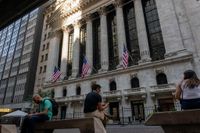Asian and U.S. financial markets paused for breath on Thursday, September 25, 2025, as investors digested a flurry of economic data and shifting signals from central banks. The day brought a mix of cautious optimism, uncertainty, and a dash of drama in the currency markets, all set against the backdrop of evolving expectations for U.S. interest rates and a technology sector that refuses to slow down.
According to Reuters, the Asian stock market, after a robust rally, took a step back. The MSCI’s broadest index of Asia-Pacific shares outside Japan slipped 0.11 percent, ending a run that had seen gains of 5.5 percent for the month and 9 percent for the quarter. Japan’s Nikkei managed a modest 0.1 percent rise, building on impressive monthly and quarterly advances of 7 percent and 13 percent, respectively. Meanwhile, China’s CSI 300 Index climbed 0.70 percent, while Hong Kong’s Hang Seng barely budged, dipping just 0.018 percent.
But it was the currency market that stole the spotlight in Asia. The Japanese yen tumbled to a one-year low of 174.78 against the euro—just a hair’s breadth away from its record low of 175.9. Against the Swiss franc, the yen hit an all-time low of 187.30. The dollar, meanwhile, dipped 0.1 percent to 148.77 yen, and the U.S. dollar index slipped 0.13 percent to 97.75. According to Bloomberg, the Swiss National Bank was widely expected to keep its policy rate at zero later in the day, marking its first pause since late 2023.
On Wall Street, the mood was equally cautious. U.S. stock futures showed only slight movement: S&P 500 and Nasdaq futures inched up 0.07 percent and 0.05 percent, respectively, while Dow Jones Industrial Average futures ticked up 0.1 percent. The previous two trading sessions had seen stocks retreat, ending a historic rally that had been fueled by hopes of Federal Reserve rate cuts and excitement over advances in artificial intelligence. As CNBC reported, investors were taking profits from record-high stocks, wary of what might come next.
At the heart of the uncertainty was the Federal Reserve. San Francisco Fed President Mary Daly suggested that more rate cuts were likely, though she admitted the timing was up in the air. "Additional rate cuts are likely, but when they will occur remains uncertain," Daly remarked, according to Reuters. In contrast, Federal Reserve Chair Jerome Powell struck a more cautious tone following the central bank’s first interest rate cut of the year just last week. His comments—and those from other Fed officials throughout the week—prompted Wall Street to rethink its earlier expectations of two further rate cuts in 2025.
That rethink was fueled by fresh U.S. economic data. Thursday’s numbers showed fewer-than-expected initial jobless claims and an upward revision to second-quarter GDP growth, indicating the U.S. economy was on firmer footing than many had believed. According to MarketWatch, these surprises led traders to scale back their bets on aggressive rate cuts. The market-implied likelihood of a quarter-point rate cut by the Fed in October slipped to 85.5 percent from 91.9 percent just a day earlier. Expectations for a similar move in December also fell, and the chances of further easing into 2026 receded.
Yet, despite the strong data, a sense of unease lingered. Investors kept a close eye on the looming release of the Federal Reserve’s favored inflation measure—the Personal Consumption Expenditures (PCE) index—set for Friday. As The Wall Street Journal noted, if inflation picks up too quickly, it could force the Fed to hit the brakes on additional rate cuts, potentially unsettling markets further. Weekly U.S. jobless claims data, released Thursday, added another layer to the puzzle, offering fresh insights into the labor market’s resilience.
Meanwhile, the technology sector continued to hum with activity, seemingly unfazed by the monetary policy debate. Alibaba announced plans to invest over $50 billion in artificial intelligence initiatives, reinforcing its determination to remain at the forefront of the AI revolution. Intel, for its part, has been in talks with Apple about a possible investment aimed at reviving its struggling business. In a show of confidence, Nvidia unveiled a $100 billion partnership with OpenAI and revealed a $5 billion investment in Intel just the previous week. According to CNBC, these moves highlight the relentless pace of innovation and competition in the tech industry—even as the broader market treads carefully.
On the commodities front, gold edged up 0.09 percent to $3,738.40 per ounce after a 0.7 percent drop the previous night, buoyed by the slightly weaker dollar. Oil prices, which had surged 2.5 percent on Wednesday to reach their highest levels since August 1, took a breather: Brent crude futures slipped 0.38 percent to $69.05 a barrel, and U.S. West Texas Intermediate crude fell 0.42 percent to $64.72.
For retailers, the spotlight turned to Costco, set to release its earnings report later on Thursday. Analysts were eager to see if the company’s reputation for bargains would help it weather the economic uncertainty, with many predicting a rise in sales as consumers hunt for value. As Bloomberg pointed out, the performance of consumer-facing companies like Costco offers a real-time window into household sentiment and spending patterns.
As the week draws to a close, investors find themselves in a familiar dance: parsing every word from central bankers, scrutinizing economic data for hidden signals, and watching the tech giants make ever-bolder bets on the future. The recent pause in the market’s rally, the dramatic moves in currency markets, and the tempered expectations for rate cuts all point to a financial world in flux—one where certainty is in short supply and surprises seem to lurk around every corner.
Still, for all the headline-grabbing moves and policy debates, the underlying story remains one of resilience and adaptation. Whether it’s the yen’s historic lows, the Fed’s shifting stance, or the tech sector’s relentless push forward, markets are constantly recalibrating—sometimes pausing, sometimes surging, but always searching for the next opportunity.




